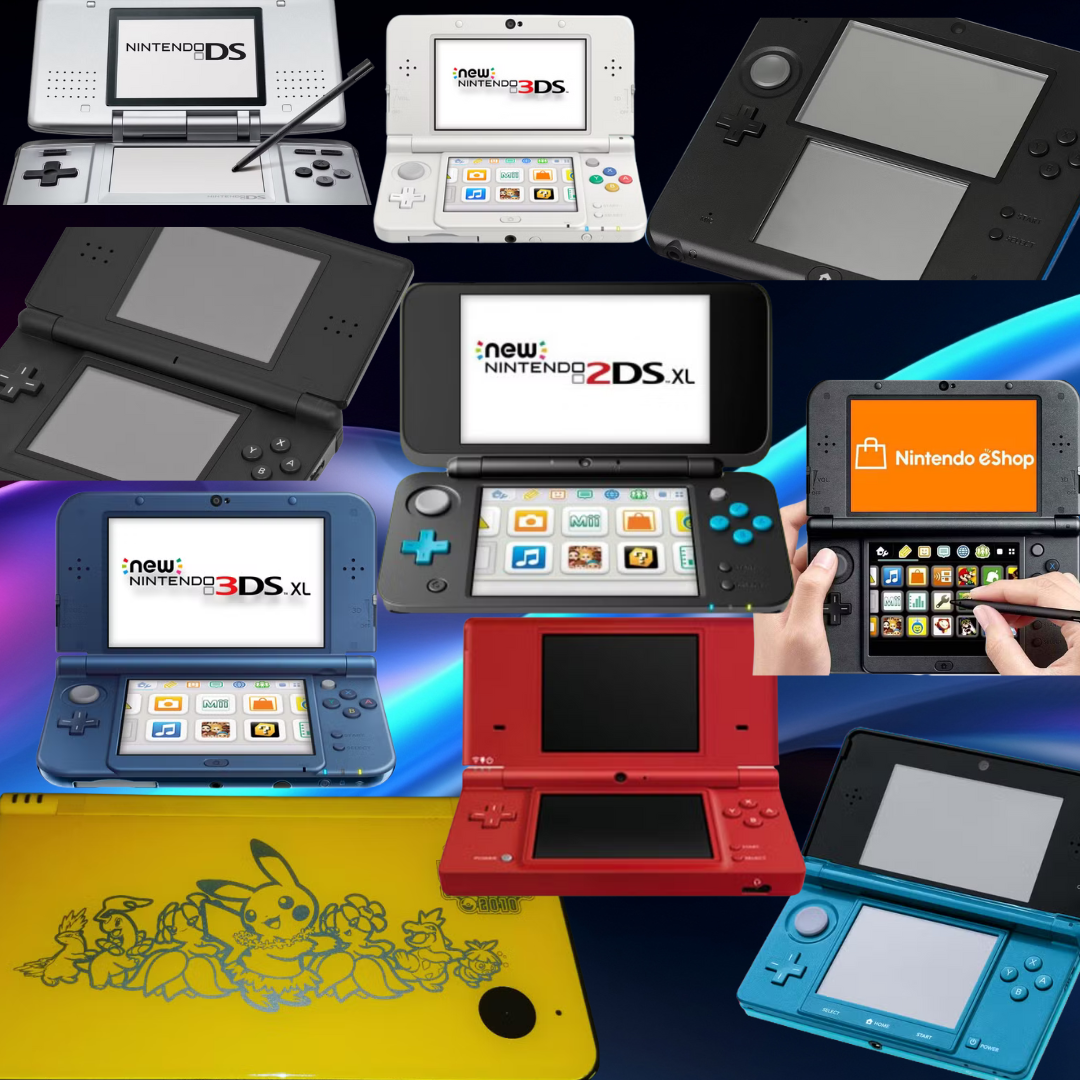
🎮 Ranking Every Nintendo DS & 3DS Model: From Worst to Best
Compartir
🕹️The Legacy of the Nintendo DS & 3DS
Nintendo has dominated the handheld gaming market for decades, but one of its most revolutionary product lines was the Nintendo DS and its successor, the Nintendo 3DS. These iconic consoles introduced dual-screen gaming, touchscreen controls, and even glasses-free 3D technology, making them beloved by millions worldwide.
With multiple iterations released over the years, each version brought unique improvements (or, in some cases, drawbacks). In this ultimate ranking, we’ll break down every Nintendo DS and 3DS model, from the least impressive to the all-time greatest!
Ready to see which Nintendo handheld reigns supreme? Let’s dive in! 🎮🔥
🔟 10. Nintendo DS "Phat" (2004) – The Grandfather of Dual Screens 👴
💾 Key Features:
- First-ever dual-screen Nintendo console
- Touchscreen on the lower display
- Backward compatibility with Game Boy Advance (GBA) games
🔻 Why It’s Ranked Low:
While the original Nintendo DS was groundbreaking at launch, it now feels outdated. Bulky design, dim screens, and a mushy D-pad make it far less enjoyable compared to its successors. However, it laid the foundation for one of the best-selling gaming lines of all time.
⭐ Verdict: A nostalgic classic, but there are much better options today.
9️⃣ 9. Nintendo 2DS (2013) – The Budget-Friendly Brick 🧱
💾 Key Features:
- Affordable alternative to the 3DS
- Sturdy, kid-friendly design
- Compatible with all Nintendo 3DS games (without 3D)
🔻 Why It’s Ranked Low:
The Nintendo 2DS was meant to be a budget-friendly option for younger gamers. However, removing the clamshell design and 3D effect made it feel less premium. The tablet-like form factor isn’t as portable, and the lack of stereoscopic 3D is a dealbreaker for some.
⭐ Verdict: Great for kids, but older gamers might want something sleeker.
8️⃣ 8. Nintendo 3DS (2011) – The Dawn of Glasses-Free 3D 😲
💾 Key Features:
- Glasses-free 3D screen
- Improved graphics over the DS
- Introduced the Circle Pad for analog control
🔻 Why It’s Ranked Lower:
The original 3DS was a huge leap forward, but its small screen, poor battery life, and early 3D issues held it back. Later models improved the 3D stability and overall comfort, making this version feel outdated.
⭐ Verdict: A historic innovation, but later models refined the experience.
7️⃣ 7. Nintendo DS Lite (2006) – Sleek, Stylish, and Iconic 😎
💾 Key Features:
- Brighter screens than the DS Phat
- Slimmer, more compact design
- Better battery life than the original DS
🔻 Why It’s Ranked Lower:
The DS Lite was a massive improvement over the first DS, but later models would add more power and features. Still, it remains a fan-favourite for its sleek design and classic aesthetic.
⭐ Verdict: A stylish, nostalgic favourite, but missing modern upgrades.
6️⃣ 6. Nintendo DSi (2008) – Online Gaming Begins 🌐
💾 Key Features:
- Larger screens than the DS Lite
- Front & rear cameras for taking pictures
- Introduced the Nintendo DSi Shop
🔻 Why It’s Ranked Lower:
The DSi improved almost every aspect of the DS Lite, but it removed the Game Boy Advance slot, making it less versatile for those who still loved GBA games.
⭐ Verdict: A great step forward, but the GBA slot removal was a controversial move.
5️⃣ 5. Nintendo DSi XL (2009) – The Bigger, The Better 📺
💾 Key Features:
- Massive screens for an immersive experience
- Enhanced speakers for better audio
- Longer battery life than the standard DSi
🔻 Why It’s Ranked Lower:
While the larger screens made gaming more enjoyable, the DSi XL wasn’t as portable, making it less convenient for on-the-go gamers.
⭐ Verdict: Great for home use, but a bit too big for portability.
4️⃣ 4. Nintendo 3DS XL (2012) – Bigger Screens, Better Gaming 📏
💾 Key Features:
- Larger screens for a better experience
- More comfortable ergonomic design
- Longer battery life than the original 3DS
🔻 Why It’s Ranked Lower:
The 3DS XL improved everything about the original 3DS, but it still suffered from early 3D stability issues, which would be fixed in later models.
⭐ Verdict: A major upgrade, but not the final form.
🥉 3. New Nintendo 3DS (2014) – Customisation & Power 💪
💾 Key Features:
- Faster processor for better game performance
- Face-tracking 3D for improved depth effects
- Interchangeable faceplates for customisation
🔻 Why It’s Ranked Lower:
While this was a huge improvement, the larger XL model provided a superior experience for most players.
⭐ Verdict: A great upgrade, but the XL version wins out.
🥈 2. New Nintendo 2DS XL (2017) – The Best Without 3D 🤩
💾 Key Features:
- Large screens, lightweight design
- More powerful processor than previous models
- Affordable and no distracting 3D effect
🔻 Why It’s Ranked Second:
This model delivers the best 3DS experience minus the 3D, making it a great option for those who never used the feature. However, for those who love 3D, the top spot goes to...
⭐ Verdict: The best non-3D version of the 3DS.
🏆 1. New Nintendo 3DS XL (2015) – The Ultimate DS & 3DS Model 👑
💾 Key Features:
- The best 3D stability ever on a handheld
- Larger screens, better battery life, and improved performance
- C-Stick and extra shoulder buttons for more control
⭐ Verdict: The New 3DS XL is the ultimate DS and 3DS experience, offering the best balance of features, power, and comfort.
🎯 Conclusion: Which Model Should You Buy?
If you’re looking for the best overall 3DS model, go for the New Nintendo 3DS XL. If you don’t care about 3D, the New Nintendo 2DS XL is the best choice.
For collectors, the DS Lite and DSi XL are still worth having for nostalgia!
What’s your favourite DS or 3DS model? Let us know in the comments! 👇🎮
